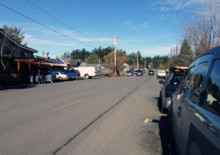Updated
— by Matthew Gilbert, Orcas Issues reporter —
Although the recent release of the Prune Alley Street Improvement Project “conceptual design” took many Orcas Islanders by surprise – and triggered a torrent of negative comments – the project has been on the books since 2003 when, according to Public Works Director Colin Huntemer, “the County commissioned an Eastsound streetscape plan that included Prune Alley.” In 2012, the project was incorporated into the County’s 6-Year Transportation Improvement Plan. One year later, says Huntemer, “former EPRC member Fred Klein drafted a revised streetscape plan for Prune Alley.”
Since then, public input and refinements to the design plan have been coordinated by the county working in conjunction with the EPRC (Eastsound Planning Review Committee). In the spring of 2017, as part of an Eastsound visioning process, the EPRC convened two sub-committees of members and citizens: one focused on “Eastsound Character” and the other on “Parking, Lighting, Infrastructure & Transportation.”
Approximately a year later, both teams recommended that whatever lighting is selected should be IDA-compliant (International Dark Sky Association): low angle, non-glare, and of a low color temperature. The groups were split on lighting at crosswalks but both emphasized low-level path lighting and pedestrian safety. The results of their deliberations were sent to the County Council.
A draft report of lighting standards for Eastsound was released in April of 2019. It emphasized adherence to IDA guidelines, provided images of various lighting options – from path lighting (street-level bollards) to overhead verticals, and included a list of “Prohibited Lighting”:
- No lighting mounted higher than the peak of the building being served or no higher than 20 feet if no buildings are present, preferably lower.
- No mercury vapor lighting.
- No lighting of any kind visible from the property line that blinks, flashes, rotates, or of unusually high intensity or brightness.
At this point, the decision on the table is not so much whether or not to have lighting but which mix of lighting to use where as there are infrastructure constraints, budget limitations, and a range of impacts to town character and local properties. And while admitting that the County could have done a better job of communicating, Councilman Rick Hughes is hoping that the overall project “becomes a model” for subsequent development.
The work is being funded by multiple sources including property taxes, Motor Vehicle Fuel Taxes, Vehicle Registration Fees, Real Estate Excise Taxes, Federal Surface Transportation Block Grants, and the State Water Quality Combined Funding Program.
How the impact of COVID on county finances affects these sources remains to be seen as the project goes forward. The county has been working with a Seattle consulting firm since “no one here in the county bid on it,” explains Hughes.
In speaking to public concerns about the project’s scope, “The only intention,” says Huntemer, “is to design and construct Prune Alley in accordance with the recommendations of EPRC, affected property owners, and the community at large. As with every transportation project, the Council has consistently requested we facilitate a public process for design elements and has supported the ensuing recommendations. As a public local advisory committee, EPRC has been charged with leading the public process with support from this department.”
With pressure on the county to make final decisions quickly given a narrow window of scheduling and financing, the EPRC is working to set up a series of meetings over the next few weeks to elicit public input. In the meantime, you can send comments directly to pubwks@sanjuanco.com. Lighting, while critical, is not the only proposed upgrade to the second of Eastsound’s two main downtown streets.
**If you are reading theOrcasonian for free, thank your fellow islanders. If you would like to support theOrcasonian CLICK HERE to set your modestly-priced, voluntary subscription. Otherwise, no worries; we’re happy to share with you.**









Is there a way to view the proposal and comment online? Comment period deadline? Thanks!
Again. Unnecessary urban nonsense. What happened to rural character?
Currently, cars are parked bumper to bumper from main street north. This effectively prevents pedestrians from walking on the sidewalks. This is a safety feature as it prevents them from being injured by stepping in the ruts and mud holes that currently line that street.
The next meetings to discuss this plan are important in order to make informed decisions on safety and visual impact in Eastsound. The community must stay vigilant as with the Deer Harbor Bridge project the Deer Harbor Plan Review Committee and a meeting of local residents both voted in the majority to require stop signs to slow traffic at the bridge in order to safeguard pedestrians. The County ignore this majority and instead convinced us that pedestrian walkways would be painted on both sides of the bridge to designate safe zones for pedestrians. When asked why the walkways were not painted on the bridge the local residents were told it was too dangerous. You guessed it – it was too dangerous as pedestrians would feel a false sense of security on the walkways because the vehicles were DRIVING SO FAST. Don’t let this happen to Eastsound. Sidewalks may make it safer for some folks but the sidewalk in front of the new apartments across from the Odd Fellows are dangerous for wheel chairs as they are too narrow with a curb drop off. Is the lighting for safety or for “quaintness”? What happens if the lighting looks good on paper but not installed? Will they be lit 24/7 or just evenings when pedestrians are present. Hopefully the EPRC will address these questions with a meeting we can all attend. Eastsound is already looking a bit tacky for my taste with all the holiday lighting and trinkets outside the stores. Lets make it safer without making it look like every other tourist destination.
If the road “improvements” heading down to Madrona Point are any indication of the improvements reserved for the rest of Eastsound… you can take your improvements and shove it.
Thanks, Matthew Gilbert, for the good reporting and for reminding people that there is a long history of research, design effort and, yes, public participation to this project. “At this point, the decision on the table is not so much whether or not to have lighting but which mix of lighting to use…” along with sidewalks, marked parking, tree plantings and public art. The EPRC and County Public Works have already held two public workshops to share preliminary designs and invite public feedback. EPRC will hold another public hearing, although the time, place and format are TBD due to COVID19 health regulations. Please watch for notices.
We should bag it – we don’t have the desire or the money. I think most of us prefer Orcas on the wilder side. Save the money for the emergency fund.
‘And while admitting that the County could have done a better job of communicating, Councilman Rick Hughes is hoping that the overall project “becomes a model” for subsequent development.’
The whole “we’ll do better next time” thing is getting old. The changes being proposed to Eastsound are not reversible, and our representatives at the County need to pay attention to what the residents are saying now.
While I’m not sure additional lighting is a must-have — but going with the premise that pedestrian safety improvements are required, has the planning commission looked at low (24 inches or lower) downward facing bollards?
As an amateur astronomer who still wants to keep light pollution down, while still ensuring visitors have safe footing when (if, ever again) they come over, we installed the following fixtures for our driveway/pathway:
http://www.olympus-mons.net/PruneAlley/Landscape_Bollards1_small.jpg
The top is about 20 inches above grade, but all the direct lighting is downward, so there’s no up-facing shine. They illuminate a circular area about 6 feet in diameter, as shown here:
http://www.olympus-mons.net/PruneAlley/Landscape_Bollards2_small.jpg
Maybe these could be spaced out every 6-10 feet, on alternating sides of the path..
No question that sidewalks are needed but I thought that the lighting was going to be rural in scale and type, something like Ken mentions above. Bollards. And the “street furniture”–is that still in there?
P.S. Yes, the project has been “on the books” since 2003. I try to follow the EPRC discussion on this but all I saw were a series of broad proposals. Did the last ones even incorporate light poles? We’ve never seen a solid proposal and certainly not urban light poles.
Apologies; I’ve been so busy following all the changes at the Port that this slipped under the radar. Plus, frankly, following this stuff ruined my health and I’m trying to take care of that now.
This same B.S. with Public Works and Planning has been going on for years. THIS is what happens when you “take the money.” Anyone who wants to form a zoom town hall on how to stop these travesties, let’s do it – because all we’re really offered here in way of a voice is this: After the engineers have made all their high-falutin’ designs and had their “workshops” where they TELL us what they’re going to do, and taken state moneys from the GMA “guidelines” which have ruined Eastsound and its surrounding forests and waters and the WETLAND it sits on, all we get to do is to maybe put a “quaint” decorative band-aid on something that needs a tourniquet! Eastsound needs a #$!* tourniquet.
And while we’re on the subject of lighting, I welcome all Eastsound and surrounding residents who want to do something about our lighting situation – both in the downtown core and in private residences. Even up on the hills far from town, you will have the same issue.
This must be stopped. We have to push back. Constant vigilance and showing up and using our voices is the ONLY way – even then it’s an exhausting and constant drain. We must use our voices also at the ballot box, and then follow through by showing up and continuing to show up.
This money the state is pouring into our urbanization and gentrification could be far better spent keeping people in their homes. I’m so disgusted.
But Sadie, if Prune Alley doesn’t look exactly like all the S. Cal suburbs we hate then how will we attract the tourists from those same locales. And then, of course, we must have a ‘model for all future developments.”
Arrgh.
I have been reduced to sputtering. This whole idea is obscene and absurd and the ‘take the money and run’ way in which the Planning c
ommission has comported itself sucks.
Basta!